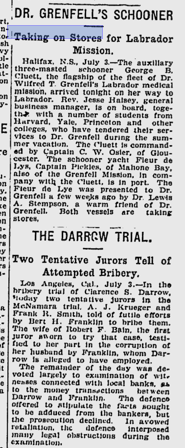 |
| c1930 |
Halsey, Jesse, clergyman, was born in Southampton, N.Y., May
3, 1882, son of Charles Henry and Melvina Dunreath (Terry) Halsey. His father
was a farmer.
After attending public schools in his native community, he
attended Princeton University and was graduated in the Class of 1906. From
1906-09 he attended Princeton Theological Seminary (N.J.) and during 1907-09
took classes at the Princeton University Graduate School. He was graduated from
Union Theological Seminary (N.Y.) in 1910 with the degree B.D. he also studied
briefly in Edinburgh, Scotland, in 1908. In 1910 he was ordained to the
ministry of the Presbyterian Church.
For three years, immediately following ordination, he was
associated with Wilfred T. Grenfell, M.D. at the latter’s medical mission on
the Labrador, acting as business manager and supervising the installation of
water and heating systems. In 1913, he returned to the United States and
lectured on the Labrador mission for a year.
A call from the Seventh Presbyterian Church, Cincinnati,
Ohio was accepted, beginning a pastorate which lasted for twenty-seven years,
until December, 1941. During this period the congregation increased from about
350 to some 800 members, and the manse and church were remodeled at a total
cost of approximately $200,000. In 1940, he became visiting professor of
practical theology and liturgics at McCormick Theological Seminary, Chicago,
Illinois. The following year he resigned his pastorate to accept a fulltime
professorship, a position he held until his retirement in 1952. Previously,
during the summer of 1937, he lectured at Union Theological Seminary (N.Y.)
under the auspices of Columbia University.
Following his retirement he again resided in Southampton,
N.Y., where he served as interim pastor to a number of churches: the Amalgamated
Presbyterian Church there, the Cutchogue (N.Y.) Church, the Presbyterian
Churches in Amagansett and Montauk, the Cutchogue (N.Y.) Church, and the
Jefferson Presbyterian Church, Brooklyn, N.Y.
As a churchman he served as Vice-Moderator of the 121st
General Assembly of the Presbyterian Church in the United States of America.
Enlisting the help of his congregation, he took a prominent part in the reorganization
of the pension system of the church and in the establishment of the Board of
Pensions for retired ministers and their widows. He was an active member of the
denomination’s Committee on Camp and Church Activities and compiled a popular
devotional booklet entitled Think on
These Things for distribution to service men.
Ohio Presbyterians elected him Moderator of the Synod in
1940. Wise in counsel, he sat on every major committee of the Synod from time
to time, and his interest in the aged number him among those who helped to
establish the Ohio Presbyterian Homes, on whose directorate he served. The
College of Wooster recognized him in 1927 with the degree Doctor of Divinity.
A leading citizen in Cincinnati, he served on the
Americanization Committee and the Associated Charities Board. He was a director
of the Bethesda Hospital and a trustee of Western College, Oxford, Ohio. From
1938-39 he served as President of the Council of Churches and a Trustee of the
Lane Theological Seminary. He was a charter member of the Cincinnatus
Association and of the Consumer’s League, a leading member of the Ministerium,
and active in the Literary Society. He was also a member of the Rotary and
Country Clubs of Cincinnati. Organizer of the Monday Morning Breakfast Club, he
became beloved Dean of Cincinnati’s clergy.
His military experiences began in 1917 when he was granted
leave by the Seventh Presbyterian Church, Cincinnati, to serve with the
Y.M.C.A. as a secretary going from Vladivostok across Siberia to Moscow where
he was on duty during the Kerenski and Bolshevik revolutions. In 1918, he
became American representative and chaplain to British naval forces in
Murmansk, Russia, and Red Cross worker. During World War II he served on the
Presbyterian Committee of Camp and Church Activities. He was assigned during
1944-45, visitor to the 6th Army and Navy Chaplains.
He was well-known for his manual skills. Many a country
church in the Cincinnati area, under his supervision, was rewired, remodeled,
refurbished, or repainted. He was a skilled poly-chrome artist. His stained
glass medallions were shown in arts and crafts exhibits in New York City. And
the garden of many a parishioner bloomed with flowers he had transplanted from
his own beds.
In addition to contributing articles to religious and
secular publications, he was the compiler of A Living Hope, the Abingdon Press,
1932, and Open Prayer, Abingdon-Cokesbury, 1951.
He was married at Lake Placid, N.Y., March 26, 1910, to
Helen, daughter of Frederick Asher and Laura Haynes Isham (q.v.), and had five
children: Charles Henry, Frederick Isham (died while a college student), Helen
Augusta (wife of theologian Dr. Joseph Haroutunian), Wilmun Haynes (who died in
childhood), and Abigail Fithian (wife of noted physicist Dr. James Alfred Van
Allen).
At one time a Republican, he later became independent
politically. From his retirement until 1954, he was President of the
Southampton Historical Society and active in community affairs. Jesse Halsey
died in Southampton, N.Y., January 12, 1954, and is buried in the village
cemetery.


























.jpg)






















